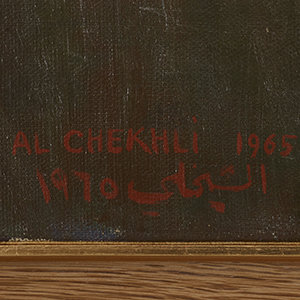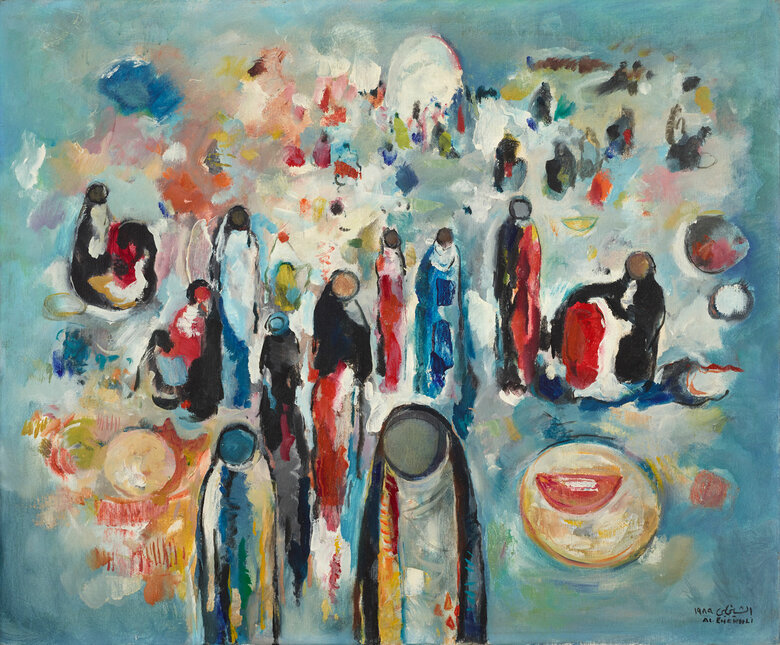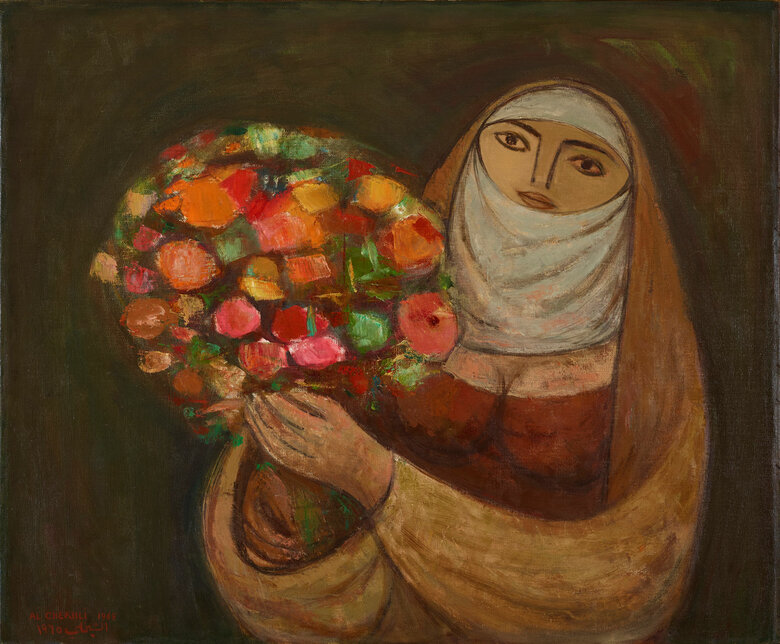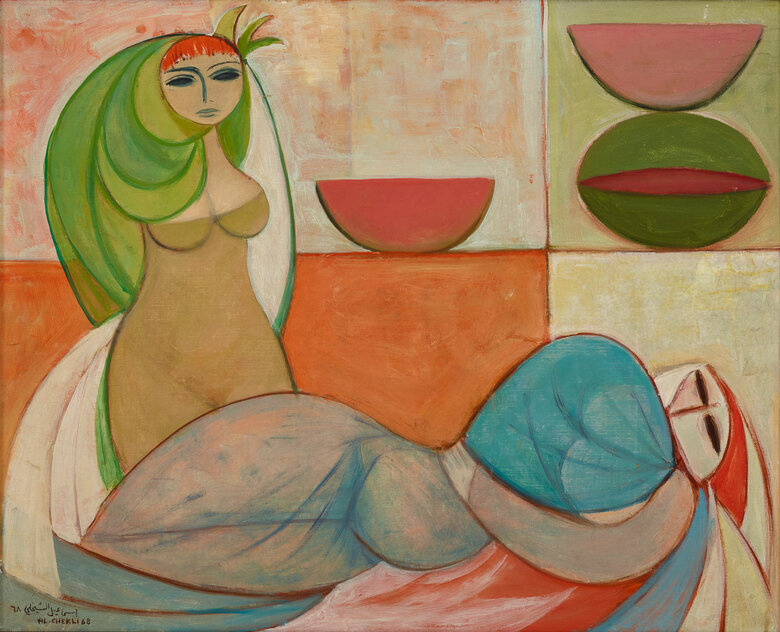Born in 1924 in Baghdad, Ismail Al-Cheikhli became a pioneer of modern Iraqi art and spent his life dedicated to organizing and promoting art and culture across Iraq and the wider Arab world....


ISMAIL Al-CHEIKHLI, Iraq (1924 - 2002)
Bio
Written by MYSA KAFIL-HUSSAIN
Born in 1924 in Baghdad, Ismail Al-Cheikhli became a pioneer of modern Iraqi art and spent his life dedicated to organizing and promoting art and culture across Iraq and the wider Arab world. Al-Cheikhli attended the Institute of Fine Art in Baghdad, completing his studies in 1945 as part of the first graduating class at the institute. Taught by master artist, Faik Hassan, Al-Cheikhli was considered a very gifted student and was chosen as the first alumnus from the institute to study abroad. He attended Paris’ École Nationale Superieure des Beaux-Arts in the early 1950s, and when not studying, he would be painting landscape scenes inspired by the French capital.
Upon his return to Baghdad, Al-Cheikhli joined the innovative Pioneers Group (ar-Ruwad, also known as Société Primitive), eventually replacing the group’s leader, his former teacher, and mentor, Faik Hassan, in 1962. Hassan, and the Pioneers Group, as a collective, often chose to focus on the environment and natural world, depicting rural life and the characters within it. Al-Cheikhli was deeply influenced by both the group and his mentor in his early work, creating paintings centered on Iraq’s villages, away from the chaos of the more urban parts of the country.
Within the traditional, rural settings of his early work, Al-Cheikhli experimented with portraying women, developing a distinctive colorful spirit in his depictions of the female form. Vibrant, dynamic, and full of life, Al-Cheikhli’s work utilized themes and motifs which Iraqi artists often employed: such as the watermelons, as well as the clothing and the oval faces typical of Iraqi artists at the time. In essence, it was a means for those artists to ‘localize’ and contextualize the subjects of their paintings. However, this formative period did not define his entire artistic oeuvre, and he shifted and transformed his practice often throughout his life.
“I cannot draw up a clear sketch of my artistic development….My art developed in a very natural way by relying on my colleagues of the Pioneers’ Group and on the physical nature of Iraq and its environment. I dealt with social themes. That is why they call me the painter of the village. I painted village women and village people. In my view, the people of Iraq are not the salon and palaces people. They are the rural people. We see them even in Baghdad. I am therefore not just the village painter but the painter of ordinary, simple people. This did not, however, detach me from the spirit of contemporary art. I paint Iraqi scenes with contemporary style. My style may evolve even further and take a different course. What that will be, is a difficult thing to say.”
Ismail Al-Cheikhli - Ur Magazine, No.1, 1980
Following this period, Al-Cheikhli’s work became more abstract, occasionally drifting into misty impressionism, with the artist depicting crowded scenes, still very much within an Iraqi atmosphere (specifically villages and rural landscapes). Bustling with energy, two untitled artworks at the Dalloul Art Foundation collection, dated 1981 and 1989, are prime examples of this stage of his artistic development. Again populated predominantly by women - this time in large groups - distinctive by their abayas (cloaks) draped over their heads, they emerge out of a distant amalgamation of shapes of varying sizes and colors – some structured, some chaotic, and all somewhat fluidic.
In addition to his time leading the Pioneers Group, Al-Cheikhli was a key member of other groups and organizations throughout his career, most notably the Iraqi Artists Society and the Society of Iraqi Plastic Artists. However, his most significant role was as Director-General of Visual Arts in Iraq under the Baath Party. Working within the stringent policies of the party, Al-Cheikhli tried to encourage artistic projects, particularly amongst Iraqi youth. This role also enabled him to commission public works by local sculptors, and to purchase local and international art for the National Museum of Modern Art, which just a few years after his appointment would be renamed the ‘Saddam Arts Centre.’ While Al-Cheikhli took on the role with an enthusiastic sense of duty, he considered it as secondary to his true calling as an artist:
“I refuse to become a civil servant. I am an artist. I lived as an artist and worked as an art teacher for 30 years, but the political leadership of the country chose me to look after the affairs of other artists as Director-General of Visual Arts. I am not far away from art. I am here to serve art and my art students and my colleagues. Yet, there is no doubt that my present position is keeping me behind in my creative activities. It is very true that during last year I produced nothing at all. I hope this will not last long.”
Ismail Al-Cheikhli - Ur Magazine, No.1, 1980
Al-Cheikhli exhibited his work all over the world, as part of the Pioneers’ annual exhibitions, and in revolutionary group exhibitions which put Iraqi art on the international stage in countries such as the United Kingdom, France, India, China, Russia, as well as throughout the Arab world. He also exhibited often with his wife, Suzanne Al Cheikhli, a talented artist and a member of the Pioneers Group, both husband and wife, striving to represent Iraq’s people and its environment through their colorful canvases. Ismail Al-Cheikhli continued to paint for much of his later life and passed away in 2002 at the age of 77 in his home city, Baghdad.
Sources
Ahmad, Mahoud. إسماعيل الشيخلي (5فنانون عراقيون - ), Ministry of Culture – Department of Plastic Arts, Baghdad, 1982
Alwan, Razaq. “في ذاكرة السنوية الاولى: اسماعيل الشيخلي احد رواد التشكيل العراقي الذين ارخوا لبغداد باللون”, Addustour.com, Accessed February 19 2020. https://www.addustour.com/articles/465623-ذا
Azmi, Khalis. “الفنان إسماعيل الشيخلي: حزين لا ينضب من المعرفة الإنسانية والميدانية”, Tashkeel: Plastic Art Magazine, No. 2, 2008
Kishtany, Khalid. “Iraqi Art in the 1950s: An interview with Ismail Al-Shaykhali”, Ur Magazine, No. 1, pages 43-49, 1988
Ni’met, Ayman Amer" تحولات الايقاع اللوني في رسومات الفنان اسماعيل الشيخلي" ., لارك للفلسفة واللسانيات والعلوم الاجتماعية (Iraqi Academic Scientific Journals), Vol.3, No. 28, 2018
Ni’met, Dr. Madi Hassan. “إسماعيل الشيخلي أعماله تجمع بين الحداثة والميثلوجيا الإجتماعية “, Elsada.net. Accessed February 19, 2020. http://elsada.net/55649
al-Adab Revue Mensuelle Culturelle, Year 4, No.1, 1956 “نحن والفن”
Iraqi Plastic Artists Society, http://www.iraqipas.com/
CV
Group Exhibitions
2012
Fifty Years of Love for France and Iraq, French Institute, Baghdad, Iraq
2009
Modernism and Iraq, Miriam and Ira D. Wallach Art Gallery, Columbia University, New York, USA
2005
Bagdad-Paris, Musée du Montparnasse, Paris, France
1979
Contemporary Iraqi Paintings (The Iraqi Interests Section/The Association of Arab-American University Graduates), Chicago, USA
1977
Contemporary Iraqi Art, Baghdad, Iraq
1976
Against Discrimination, Baghdad, Iraq
1975
Iraqi Plastic Artists Society Exhibition, Damascus, Syria
1974
1st Arab Biennial, Baghdad, Iraq
1972
Al-Wasiti Festival (Iraqi Artists Society), Baghdad, Iraq
1971
The 14th
Exhibition of The Pioneers (S.P.), Baghdad, Iraq
Contemporary Iraqi Art Exhibition, Moscow. Russia
1966
Touring Exhibition of Iraqi Art, Vienna, Austria; Rome, Italy; Madrid, Spain; London, UK; Beirut, Lebanon
Iraqi Artists’ Society Annual Exhibition and Inauguration of the New Centre, Gulbenkian Museum (National Museum of Modern Art), Baghdad, Iraq
The 9th Annual Art Exhibition of the Pioneers (S.P.), Gulbenkian Museum (National Museum of Modern Art), Baghdad, Iraq
1965
The 8th Annual Art Exhibition of the Pioneers (S.P.), Gulbenkian Museum (National Museum of Modern Art), Baghdad, Iraq
1959
The Revolution Exhibition / Iraqi Art Exhibition, Peking, China; Moscow, Russia; Warsaw, Poland; Sofia, Bulgaria; Belgrade, Serbia (formerly Yugoslavia)
1957
Iraqi Art Exhibition, Beirut, Lebanon
1955
Contemporary Iraqi Art Tour, India
1954
Al-Mansour Club, Baghdad, Iraq
1953
Exhibition in Alexandria, Egypt
1951
French Artists Society Exhibition, Paris, France
Iraqi Art Exhibition, Cairo, Egypt
1946
Exhibition of the Society of the Friends of Art, Baghdad, Iraq
Affiliations & Memberships
1945
Member, The Pioneers, Iraq
1956
Founding Member and Treasurer, Society of Iraqi Plastic Artists, Iraq
1960s
Member, Iraqi Artists Society, Iraq
1962
President/Leader, The Pioneers, Iraq
1979
Director-General of Visual Arts, Ministry of Culture, Iraq
Collections
Dar al-Anda, Amman, Jordan
Hussain Ali Harba Collection, Italy
Ibrahimi Collection, Amman, Jordan
Jordan National Gallery of Fine Art, Amman, Jordan
Mathaf: The Arab Museum of Modern Art, Doha, Qatar
The Ramzi and Saeda Dalloul Art Foundation, Beirut, Lebanon
Documents
تحولات الإيقاع اللوني في رسومات الفنان إسماعيل الشيخلي
إيمان عامر نعمة
لارك للفلفة و السياسات و العلوم الاجتماعية, Arabic, 2018
الجزء الثالث/ العدد الثامن والعشرين
فنانون عراقيون إسماعيل الشخلي
مرهود أحمد
الجمهورية العراقية/ وزارة الثقافة و الإعلام/دائرة الفنون التشكيلية, Arabic, 1982
Press
إسماعيل الشيخلي أعماله تجمع بين الحداثة والميثولوجيا الاجتماعية
Dr. Hassan Madi Nehmeh
Al sada.Net, Arabic
في ذاكرة السنوية الاولى: اسماعيل الشيخلي احد رواد التشكيل العراقي الذين ارخوا لبغداد باللون
Al Doustour/ Amman, Arabic, 2003
ISMAIL Al-CHEIKHLI Artwork
Become a Member
Join us in our endless discovery of modern and contemporary Arab art
Become a Member
Get updates from DAF
Follow Artists
Save your favourite Artworks
Share your perspectives on Artworks
Be part of our community
It's Free!
We value your privacy
TermsCookiesPrivacy Policies
Become a Member
Get updates from DAF
Follow Artists
Save your favourite Artworks
Share your perspectives on Artworks
Be part of our community
It's Free!
We value your privacy
TermsCookiesPrivacy Policies
Become a Member
Get updates from DAF
Follow Artists
Save your favourite Artworks
Share your perspectives on Artworks
Be part of our community
It's Free!
We value your privacy
TermsCookiesPrivacy Policies
Welcome to the Dalloul Art Foundation
Thank you for joining our community
If you have entered your email to become a member of the Dalloul Art Foundation, please click the button below to confirm your email and agree to our Terms, Cookie & Privacy policies.
We value your privacy, see how
Become a Member
Get updates from DAF
Follow Artists
Save your favourite Artworks
Share your perspectives on Artworks
Be part of our community
It's Free!
We value your privacy
TermsCookiesPrivacy Policies








